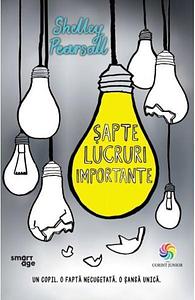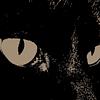Take a photo of a barcode or cover
Cute with an excellent message but occasionally felt long winded.
I listened to the audiobook---the narrator's voice was believable as Arthur, but I found the way his sister Barbara was voiced to be annoying. The story was compelling, and made me very much want to see the work of art that it concerns. Themes of how we deal with death, what is art, and how can we find redemption were really well treated. Overall I definitely loved the book.
The first chapter is a great hook! I hope my MS readers will enjoy this one -there are a lot of avenues they could take... the loss of a parent, unexpected actions from people you've already judged, art in many forms, quotes to remember, or items to cherish. I enjoyed Arthur Owens's development, and wish I could have known James Hampton a bit better.
"Everybody had a name, of course, but he had to admit he'd never thought about the Junk Man having one."
"It was a lot easier to dislike someone you didn't know anything about."
"Everybody had a name, of course, but he had to admit he'd never thought about the Junk Man having one."
"It was a lot easier to dislike someone you didn't know anything about."
A unique way to present the themes of loss and redemption while connecting to art. I remember seeing "The Throne of the Third Heaven" at the museum many years ago. I didn't make the connection to the exhibit until halfway through the book when I came across the picture at the end.
emotional
hopeful
informative
inspiring
mysterious
sad
medium-paced
Plot or Character Driven:
Character
Strong character development:
Yes
Loveable characters:
Yes
Diverse cast of characters:
Yes
Flaws of characters a main focus:
Yes
Many thanks to Random House Children's for sending me this electronic copy via NetGalley in exchange for my honest review.
The Seventh Most Important Thing caught my attention as soon as I read the description. A middle-grade story about a kid who befriends a guy known as the Junk Man who has a secret project that involves garbage? Sign me up. Seriously. I'm all about trash-to-treasure transformations. (And alliteration, apparently. Say that ten times fast.)
Inspired by the real life story of real life artist James Hampton, the concept of the book was fascinating (I mean, look up the guy on Google – he is inscrutable, and his work is completely mesmerizing!), but unfortunately, I found the execution to be lacking.
Sadly, the character development in The Seventh Most Important Thing is disappointingly weak. Shelley Pearsall really only teases at each character's story, and it seems as though there are a lot of blanket statements that are used to describe a character and that we are supposed to somehow take at face value. For example: the carpenter boyfriend who is a little too nice all the time; the alcoholic father who is loved but not a great dad; James Hampton who is an enigma at the beginning of the novel, and an enigma at the end. It feels like a sketch of a novel, and you're sort of left asking yourself, "…And?" It's like a thread on a sweater – you want to keep pulling and pulling, except there's nothing left to grab.
The one other thing that really stands out to me in a negative way is the voice. The Seventh Most Important Thing is written in the third person perspective but from what sounds like a child's voice. The language feels very juvenile, as though the author has made a point to be particularly accessible to younger audiences. It's a bit of an odd place to be, given that the main character himself is a 14-year-old boy whose childhood and family life are less rosy than the childhood and family lives of most other 14-year-old boys represented in fiction. I feel like the author maybe deliberately dumbed down the writing specifically to accommodate a younger crowd – it felt a little bit disingenuous and unnecessary to me, like she was self-consciously trying to write children's fiction and shielding her readers in the process.
On the flip side, there are definitely some very abstract, sophisticated themes in the book – like the seven most important things that Shelley Pearsall loosely and subtly explores throughout the course of the story – so I can understand why she might have wanted to take on a younger voice here. It's a very conceptual story, and at times the seven most important things get shrouded in too much symbolism, so in that sense, the language choice does make it a little bit easier to follow. And as much as I'm harping on the way the story was told, I found that the voice did grow on me a bit – the juxtaposition of concept art and youthful narrative was interesting and charming and kind of precious at times. It kept the book from feeling too heavy or philosophical or academic.
It's hard for me to come up with a really solid opinion of this book. The idea of it is fresh and interesting and unexpected, but between the way it is written and the story the author decided to tell, I have to say that it's just not my cup of tea. I actually think The Seventh Most Important Thing could've been a stronger book had it been written as an adult novel. The quirkiness of the story would have been more successful, and the narrative jump from Arthur's teen years to adulthood would have felt perhaps less jarring. I'm interested to see what others think though – maybe I'm too idealistic about what middle-grade books should be!
More reviews, including this one, on my blog: Bookplates for Brunch.
The Seventh Most Important Thing caught my attention as soon as I read the description. A middle-grade story about a kid who befriends a guy known as the Junk Man who has a secret project that involves garbage? Sign me up. Seriously. I'm all about trash-to-treasure transformations. (And alliteration, apparently. Say that ten times fast.)
Inspired by the real life story of real life artist James Hampton, the concept of the book was fascinating (I mean, look up the guy on Google – he is inscrutable, and his work is completely mesmerizing!), but unfortunately, I found the execution to be lacking.
Sadly, the character development in The Seventh Most Important Thing is disappointingly weak. Shelley Pearsall really only teases at each character's story, and it seems as though there are a lot of blanket statements that are used to describe a character and that we are supposed to somehow take at face value. For example: the carpenter boyfriend who is a little too nice all the time; the alcoholic father who is loved but not a great dad; James Hampton who is an enigma at the beginning of the novel, and an enigma at the end. It feels like a sketch of a novel, and you're sort of left asking yourself, "…And?" It's like a thread on a sweater – you want to keep pulling and pulling, except there's nothing left to grab.
The one other thing that really stands out to me in a negative way is the voice. The Seventh Most Important Thing is written in the third person perspective but from what sounds like a child's voice. The language feels very juvenile, as though the author has made a point to be particularly accessible to younger audiences. It's a bit of an odd place to be, given that the main character himself is a 14-year-old boy whose childhood and family life are less rosy than the childhood and family lives of most other 14-year-old boys represented in fiction. I feel like the author maybe deliberately dumbed down the writing specifically to accommodate a younger crowd – it felt a little bit disingenuous and unnecessary to me, like she was self-consciously trying to write children's fiction and shielding her readers in the process.
On the flip side, there are definitely some very abstract, sophisticated themes in the book – like the seven most important things that Shelley Pearsall loosely and subtly explores throughout the course of the story – so I can understand why she might have wanted to take on a younger voice here. It's a very conceptual story, and at times the seven most important things get shrouded in too much symbolism, so in that sense, the language choice does make it a little bit easier to follow. And as much as I'm harping on the way the story was told, I found that the voice did grow on me a bit – the juxtaposition of concept art and youthful narrative was interesting and charming and kind of precious at times. It kept the book from feeling too heavy or philosophical or academic.
It's hard for me to come up with a really solid opinion of this book. The idea of it is fresh and interesting and unexpected, but between the way it is written and the story the author decided to tell, I have to say that it's just not my cup of tea. I actually think The Seventh Most Important Thing could've been a stronger book had it been written as an adult novel. The quirkiness of the story would have been more successful, and the narrative jump from Arthur's teen years to adulthood would have felt perhaps less jarring. I'm interested to see what others think though – maybe I'm too idealistic about what middle-grade books should be!
More reviews, including this one, on my blog: Bookplates for Brunch.
emotional
inspiring
medium-paced
Plot or Character Driven:
Plot
Strong character development:
Yes
Loveable characters:
Yes
Diverse cast of characters:
Yes
Flaws of characters a main focus:
Yes
I got this at the thrift store because the shiny cover caught my eye. This was my filler book for a few months and I finally got around to reading more than a few chapters. I honestly really liked it; it was original in a way I didn’t expect. It gave me John Green vibes and I loved most of the characters.
Redemption. Great story, believable characters, and many heartwarming moments. I will definitely order this for the library.
The story is set through fictional teen, Arthur's eyes as he redeems himself performing community service for Mr. Hampton helping him finish a mystifying creation of art after hitting him in the shoulder with a rock.
A fictional story based on a real man and true events. James Hampton created a "Throne of the Third Heaven" or "Hampton's Throne" out of common materials.
A fictional story based on a real man and true events. James Hampton created a "Throne of the Third Heaven" or "Hampton's Throne" out of common materials.
This amazing novel starts strongly with the shocking incident of thirteen-year-old Arthur Owens inexplicably throwing a brick at the Junk Man, a trash picker often seen in Arthur's Washington DC neighborhood. Such a seemingly senseless begins to make sense, as the story continues. Arthur is ordered to complete 120 hours of community service, helping James Hampton (the Junk Man) by collecting discarded light bulbs, foil, mirrors, cardboard, pieces of wood, glass bottles and coffee cans, leaving them in an old shopping cart at Mr. Hampton's garage. The boy is confused and embarrassed, but, as the tale progresses, learns that junk can make something truly beautiful.
Based on the life and work of folk artist James Hampton, this is a great read! - Louisa A.
Based on the life and work of folk artist James Hampton, this is a great read! - Louisa A.





